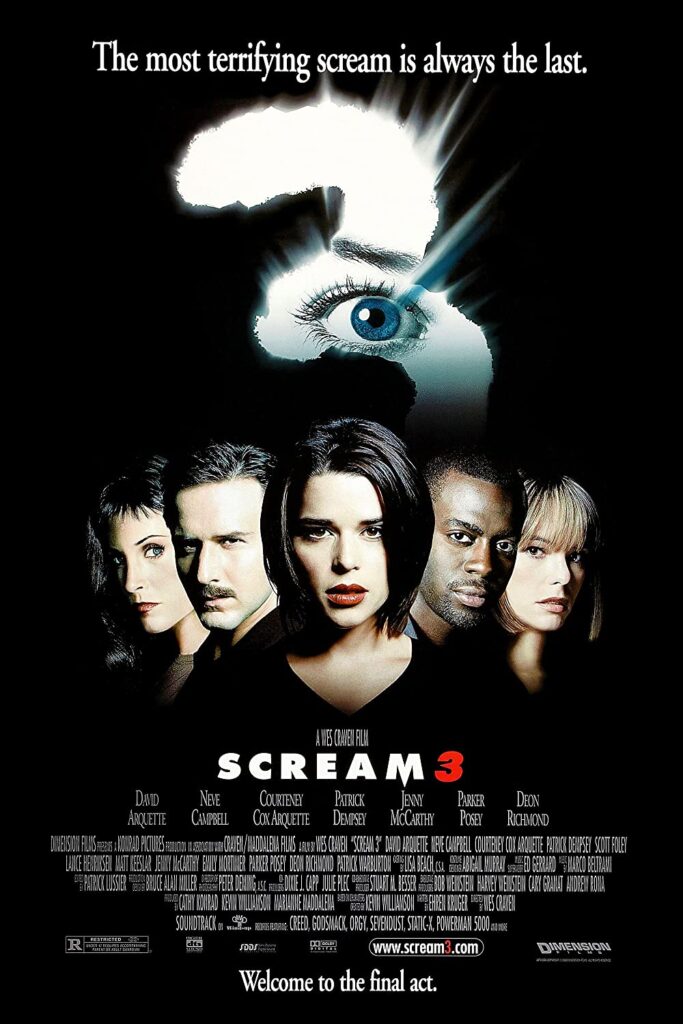“Hollywood is full of criminals whose careers are flourishing.”

When Scream bowed in theaters in 1996, it became a word-of-mouth slasher sensation, the likes of which hadn’t been seen since the blood-spattered box office receipts of the previous decade. And it did so precisely because it had its knives out for a genre that needed to be shaken out of its formulaic doldrums: by finally tearing the guts out of the dead horse, Kevin Williamson and Wes Craven revived it. Scream revolutionized slasher movies by lovingly poking fun at their conventions — if this series ever truly ends, this would be the leading lines of its obituary (if, for some reason, we start writing obituaries for movies). However, Scream also stepped right into the middle of a decades-long moral panic about media violence that was reaching its crescendo in the 1990s, thanks in large part to increasingly violent horror movies and video games. Via legislation and the formation of the Parents Television and Media Counsel, both sides of the political aisle sounded the alarm, insisting that violent programming would lay siege to an entire generation of Americans, creating a teenage wasteland of sex and violence that must be tamed.
Craven and Williamson couldn’t help but take their own stab at the discourse, most notably during the climax of the first film, wherein lead psycho Billy Loomis (Skeet Ulrich) laughs off the suggestion that horror movies have warped him into committing murder. “Don’t you blame the movies,” he rants. “Movies don’t create psychos — movies make psychos more creative!” While it’s true that these words do emanate from the mouth of the film’s villain, it lays bare the absurdity of the argument, especially when Billy reveals he’s simply motivated by good old-fashioned revenge. Scream 2 would go on to further probe the exploitative nature of horror movies and media frenzies, eventually arriving at the same point during a deja vu climax where “freaky Tarantino film student” Mickey (Timothy Olyphant) is going to pin his rampage on the movies in bad faith before his accomplice/puppeteer Mrs. Loomis (Laurie Metcalf) guns him down, once again insisting that she’s just in it for revenge.
After two movies, the mantra couldn’t be more clear: our art is often violent because humans have routinely sought catharsis in violent art, and this multi-generational saga of familial revenge starts to feel like the stuff of ancient Greek tragedy. For all of their metafictional musings, the first two Scream films also confirm the timeless, primal appeal of weaving fictional violence through tales of mayhem and revenge. It would seem that Craven and company wrestled with their complicity before insisting that this kind of vicarious bloodlust is a vital part of the human experience, an outlet that acts as a surrogate for those primal urges.
Unfortunately, the Columbine Massacre in 1999 would force everyone to wrestle with that complicity. Predictably, politicians and the media — who had no qualms about exploiting the tragedy for their own ends — looked for a scapegoat in violent movies and video games, and Scream 3 found itself firmly in the firestorm. Suddenly, a movie about teens butchering each other in a small town was no longer marketable, and Dimension films quickly pivoted from Williamson’s original premise, which would have involved a group of rabid Stab fans staging another round of mayhem in Woodsboro, likely allowing Scream to again explore the intersection of violence and media. To make matters worse, scheduling conflicts made it impossible for Williamson to stick around for the pivot, leaving Ehren Kruger (with a hefty, uncredited assist from Craven himself) to script a hard left turn, taking the franchise about as far away from reality imaginable: Hollywood itself, specifically to the artificial backlot where a new Ghostface killer is terrorizing the set of Stab 3.
But instead of taking this as another opportunity to issue a rejoinder to its critics, Scream 3 acknowledges a moral rot at the core of the entertainment industry. Most of the action unfolds in the shadow of Sunrise Studios, a fictional exploitation movie factory standing in for the likes of American International Pictures or New World Pictures (with a cameo from Roger Corman himself all but confirming the parallels). The admittedly clever conceit does allow the film to make its typical meta musings: during his cameo, Corman’s studio exec laments the negative publicity that a string of actual murders will bring (“Violence in cinema is a big deal right now — this is not the kind of news this studio is after!), while Stab 3’s chaotic shoot allows Kruger to make light of his own disheveled production, where pages were frequently rewritten on the fly.
This time out, however, Scream seems largely disinterested in this stuff, as it seems to have gone out the door with Williamson. His departure leaves an obvious void in this respect, stripping the film of its predecessors’ authenticity in this realm. Even if favorite Randy returns from the grave via a recorded message, this time issuing warnings and rules about horror trilogies, it feels forced and rings false. Trilogies aren’t simply a rarity in the horror genre, as he admits, but were practically nonexistent at the time (and the few that existed certainly didn’t abide by these rules)*. Where the first two Scream films name-dropped genuine slasher movies of both the mainstream (Halloween, Friday the 13th, etc.) and obscure (The Door that Dripped Blood) persuasions, Part 3 is couched in a phony history: instead of featuring genuine AIP horror hits, it outfits Sunrise Studios with posters for fake movies, seemingly in a concerted effort to remove Scream 3 from any semblance of reality.
By the time Jay and Silent Bob stroll through the backlot, you begin to wonder if this third entry isn’t lapsing into self-parody, something that would admittedly be fair game considering how often slasher franchises get away from themselves. Scream 3 doesn’t seem particularly interested in this, either, though, and its absurd tenor feels like the product of Dimension’s mandate to boost the comedy elements rather than any desire to make genre commentary. When forced to genuinely confront the relationship between fictional violence and actual violence, the studio seemingly blinked and scurried off to refuge in an artificial depiction of an already plasticine land of make-believe. The jarring change in tone and location is an escape plan allowing it to skirt the issues that inspired them in the first place, and Corman’s beleaguered exec feels like a parting shot to the discourse before Craven and company stage a ludicrous riff on the Scream formula, complete with explosions and Stab 3 cast member doppelgangers joining the fray.
But try as it might to avoid reality, Scream 3 can’t help but stumble into the grim truth of Hollywood’s history with a different type of exploitation: the procession of young, wide-eyed starlets who have been routinely chewed up and spit out by this dream factory, their innocence corrupted by sleazy casting couch exploits and bacchanalian parties. In the film’s most vital and intriguing subplot, returning journalist Gale Weathers (always an eager participant in the exploitation machine) discovers that Maureen Prescott (whose murder precipitates the franchise’s mayhem) was once Rina Reynolds, one of those starry-eyed girls whose dreams of Hollywood fame and glory corroded in a Tinseltown crucible of corruption. She was one of the many victims of Sunrise Studios exec John Milton (whose name suggests Hollywood is some kind of Edenic lost paradise), a notorious producer whose infamous parties often treated young stars like Rina Reynolds as currency.
This revelation grounds the otherwise outrageous sequel, giving it a dimension of authenticity as it confronts an exploitative culture that hasn’t just operated under everyone’s noses — it’s been an open secret, something that’s embedded into Hollywood lore. If you want to be a star, you have to play the game — at least until the game is done with you. Scream 3 might shirk the issue of media violence, but it doesn’t hesitate to point an accusatory finger at Hollywood’s perpetuation of real violence against women. Rina Reynolds’ story isn’t the stuff of fantasy — it’s the story of an untold number of victims that suffered a similar fate at the hands of conniving charlatans behind the scenes.
It’s very tempting to hail Scream 3 as a prescient, subversive production, a sequel with so much cultural and financial clout that its creators felt emboldened to burn the whole industry down. Here’s a movie shining a light on Hollywood corruption years before the #MeToo movement would thrust it into the spotlight, outing predators and even bringing some of them to justice. Scream 3 doesn’t exactly mince words on the subject, either: John Milton is an unrepentant scumbag who doesn’t shy away from his misdeeds when he’s confronted about his role in running Reynolds out of Hollywood:
“I’m saying things got out of hand. Maybe they did take advantage of her, you know? Maybe the sad truth is this is not the city for innocence. No charges were brought. And the bottom line is Rina Reynolds wouldn’t play by the rules. You wanna get ahead in Hollywood, you gotta play the game or go home.”
As Milton’s ruthless words unfold, you can’t help but wonder how many victims this tacit agreement has claimed for decades. How many women came to Hollywood as Rina Reynolds — young, full of hopes and dreams — but left as Maureen Prescott — broken, disillusioned, haunted by a past that can never be passed? How many John Miltons have stalked parties, auditions, and sets? He’s not the film’s ultimate villain, but he’s a shitheel all the same, a ghoul whose eventual murder feels righteous and much deserved. For a brief moment, Scream 3 sketches an unhinged portrait of Hollywood coming unglued as Stab 3 director Roman Bridger — now revealed to be the killer and the offspring of one of Reynolds’ illicit affairs — berates his producer before killing him, taking vengeance for a mother who could never love him. This dream factory only produces nightmares, and the only solution is to purge its demons.
Which is all well and good, only Scream 3 itself is prominently haunted by a notorious ghoul in producer Harvey Weinstein, whose reign of terror was one of the biggest revelations of #MeToo. It’s impossible to watch the film without noting the parallels of the disgraced mogul’s sordid exploits to the tales spun about Milton’s infamous parties, giving Scream an unexpected layer of metafiction that’s only made the film more fascinating in retrospect. You can’t help but wonder if it was unintentional too: in addition to setting fire to the industry, were Craven and company also biting the hand that fed them? Were they trying to sound an alarm, to let everyone know that the call was coming from inside the house? Contemporary reporting has repeatedly insisted that Weinstein’s behavior was an open secret, a pattern of abuse that was enabled for decades by a culture that seemingly shrugged at each accusation.
For their parts, Kruger and editor Patrick Lussier claim Weinstein wasn’t an explicit inspiration for Scream 3, with the former further insisting instead that Hollywood’s “imperious disregard” in general guided the script. Lussier also says the film is reflective of Craven’s own relationship with the industry: “In Wes’ mind, this was very much how this city works. We will eat into our young.” Considering the director’s tumultuous Baptist upbringing demonized filmmaking (so much so that he didn’t really discover the medium until his 20s) and his sympathy for victimized youth, it’s hardly surprising that he saw this contractually obligated sequel as an opportunity to explore the industry’s seedy underbelly’s treatment of young stars. (It’s also worth noting one of the highlights of Scream 3—a film about characters struggling to escape their ghosts—is a magnificently shot nightmare sequence that feels like Craven’s acknowledgment of his most famous specter, the one that granted his own power within this industry.)
Meanwhile, Weinstein and his brother Bob reportedly didn’t balk at a creative direction that ultimately leaves his on-screen counterpart begging for his life, promising his director final cut, only to be on the receiving end of that very promise seconds later when Roman slashes his throat. Even if he didn’t dictate anything creatively, his endorsement warps Scream 3 into a perverse confessional of sorts, the flaunting of a man so emboldened by his own power and influence that he put his name on a movie that told everyone exactly who he was and what he truly deserved—not that he ever thought he would get his just desserts, I’m sure. As much as I’d like to believe Scream 3 acts as a genuine expose of Hollywood corruption, its insistence that these terrible men will get what’s coming to them feels like the stuff of fantasy, even if Weinstein was eventually brought to justice.
It also doesn’t help that the film has an uneasy relationship with this material, ultimately exploiting it simply to grease the wheels of its own ramshackle plot. The story of Rina Reynolds/Maureen Prescott might gain another tragic dimension, but it’s once again fodder for a killer’s revenge. Had Roman Bridger set out to destroy the life of the man who destroyed his mother and avenge that cruelty, Scream 3 might have flipped the entire franchise on its head. Instead, we learn that he’s been the mastermind from the beginning, a maestro who orchestrated Billy Loomis and Stu’s original murder spree, and now he’s here to finish what they started by finally killing his own sister. Rina’s abuse becomes a footnote, her legacy simply exploited to perpetuate further violence against another woman in Sidney Prescott, the true object of Roman’s ire.
Frankly, it’s a little hard to take even this grim material seriously when it’s couched inside of a Scooby Doo ending that stretches credulity even for a Scream movie, and Dimension’s escapist mandate seems to win out in the end. Then again, by the time Roman begins ranting, raving, and whining about the life he missed out on, he cuts a striking image of oblivious privilege, a man who’s clearly had no trouble navigating and exploiting the very system he blames for this corruption; he may claim to be inspired by a woman’s mistreatment, but it’s ultimately all about him. He’s not purging Hollywood corruption for Rina Reynolds, much less on behalf of the innumerous victims that came before and after her ill-fated So-Cal stint—in the end, it’s all about him, suggesting that a woman’s pain can’t be its own tragic story. His acknowledgment of Rina’s tragedy is as glib as the previous killers’ musing on media violence—this is still just good old-fashioned revenge, with the sleazy exploits of Sunrise Studio becoming part of the franchise’s gossipy lore rather than a satisfying exploration of an abusive industry. After all, Scream 3 itself is exploiting this unseemliness and expects its audience to delight in the tabloid, tell-all nature of it all, once again allowing us to consider just how complicit we all are. In this instance, perhaps #MeToo applies not to the victims but to everyone who allows the abuse and exploitation to thrive.
Scream 3’s flirtation with genuine subversion makes it one of the most interesting — and most frustrating — entries in the series. Considering the circumstances that influenced its production, it’s remarkable that it works at all, and it represents a fascinating pivot. It’s no longer interested in (if not downright forbidden from) continuing its predecessors’ dialogue with media violence, but it’s downright eager to expose another sort of Hollywood problem, one that was infinitely more pressing than horror fans enjoying violent movies. At one point in the movie, both Roman and Milton laugh off the connection between fictional violence and real violence, with the former asking aloud “so if we stop making scary movies, what, all the psychos will retire? Come on.” His producer is quick to back him up: “I’ve been making horror movies for 30 years, never had a psycho problem,” he offers in an exchange that grows ironic as we learn more about these two. It’s the last word Scream 3 cares to have on the subject of media violence: it dismisses the notion that horror movies are inherently corrupt, but that doesn’t mean there might not be something wrong with some of the folks lurking behind the scenes.
Unfortunate circumstances sent Craven and company on a crooked path for this sequel, yet they managed to arrive at a similarly thoughtful headspace about exploitation as the previous movies, even if Scream 3 isn’t quite as articulate as those two and has felt like an odd fit since its February 2000 release. At that time, it was meant to be a trilogy capper, but the years since have made it clear that Scream 3 occupies another familiar space on the franchise trajectory: the weird diversion that doesn’t quite fit with the others. While it’s not as pronounced as the likes of Halloween III or Jason Goes to Hell, it’s a jagged piece all the same, and it’s those jagged pieces that tend to grow more fascinating in time.
*Considering the climax of Scream 3 unfolds in a gothic mansion that’s hoarding plenty of familial secrets, it would have made much more sense for Randy to bring everyone up to speed on Old Dark House movies, a clear predecessor to the slasher genre whose influence still remains.
Tags: Carrie Fisher, Courteney Cox, David Arquette, Deon Richmond, Ehren Kruger, Emily Mortimer, Heather Matarazzo, Hollywood, Horror, Jamie Kennedy, Jason Mewes, Jenny McCarthy, Kelly Rutherford, Kevin Smith, Kevin Williamson?, Lance Henriksen, Liev Schreiber, Lynn McRee, Marco Beltrami, Matt Keeslar, Neve Campbell, Parker Posey, Patrick Dempsey, Patrick Lussier, Patrick Warburton, Peter Deming, Roger L. Jackson, Scott Foley, Sequels, Wes Craven



No Comments